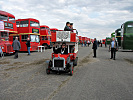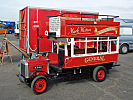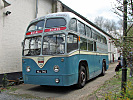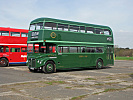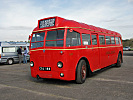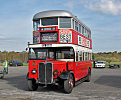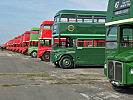Not logged in | Log in | Sign Up

Search Photos
AEC Routemaster #RM1
11 april 2010 - Wisley, Surrey (UK). Another extremely important British bus - the first Routemaster prototype of 1954 (very advanced for this time). It now lives in the London Transport Museum, but makes occasional trips to events - here, it stands alongside prototype #4, which was a Green Line coach variant.
Comments: 6
AEC Regent III/Park Royal #RT1
11 april 2010 - Wisley, Surrey (UK). The most important bus in Britain. This is the prototype of the London RT Class, the first of over 7,000 similar buses that were the classic London bus of the 1950s. It has recently been bought at a cost of GBP 150,000 (PLN 750,000) to stop it going to a collector in America.
Comments: 3
Volvo Ailsa B55 / Alexander #5385
5 april 2009 - Cobham (UK). The Volvo Ailsa was developed specially for operators who didn’t want a rear-engined double decker like the Atlantean or Fleetline. The engine is in the front, but the bus still manages to have a front entrance, so it can be one person operated. Ailsas were particularly popular in Scotland, although this one was operated by Maidstone and District in Kent and was involved in comparative trials for the National Bus Company. The fleet number painted on the roof was a typical M & D arrangement.
Leyland Tiger PS2/ East Lancs #36
5 april 2009 - Cobham (UK). In the days when many bus companies were owned by local councils, some smaller towns in UK joined together to provide local bus services, like Burnley, Colne and Nelson, three industrial towns in Lancashire. Like lots of local councils, they still bought very old-fashioned buses, long after other operators had started to buy much more modern-looking vehicles.
Leyland Tiger PS1/Park Royal #CFN 104
5 april 2009 - Cobham (UK. The East Kent Road Car Company was (as the name suggests) the major bus and coach operator in east Kent. Services also ran to London and to cities in Europe, using the cross-channel ferries. This was a dual purpose vehicle, used either on the express service to London or as a coach. East Kent buses never carried fleet numbers. The Tiger PS1 was really the final flowering of the British half-cab single deck coach.
Leyland Tiger TS7/Burlingham #7
5 april 2009 - Cobham (UK). A Leyland Tiger of 1937 converted into a breakdown wagon by Blackpool Corporation, who originally bought twelve of these as ‘sun saloons’. In 1957 it was converted as shown here and became a tramway snowplough, towing lorry and salt/sand carrier. It was finally withdrawn in 1964.
Leyland Titan PD2 RTW #RTW185
5 april 2009 - (UK). The RTW class were 500 eight feet wide buses – the first to be permitted in London. Even then, there were restrictions at first on which roads they could use and they were not allowed into the centre of the city. London buses today are even wider, and no-one complains. They carried an RT-style body with only slight modifications and were built by Leyland instead of AEC. This was eventually an LT’s Chiswick works skid bus until preserved in 1971.
Bristol K6A/ECW #446
5 april 2009 - Cobham (UK). Bristol/ECW buses - the Thames Valley Company operated buses in the Thames valley area (how amazing!) west of London and later became one half of the Alder Valley company. Their standard double decker was the Bristol K-type – a type of bus not seen on TWB before. The K6A was replaced by the Bristol Lodekka a few years later. A collectors’model of this exact bus was made.
Bristol MW6G/ECW #2250
5 april 2009 - Cobham (UK). Bristol/ECW buses - the classic Royal Blue express coach of the late 1950s. These were ‘ king of the road’ when new and connected all parts of England with London and the south coast. This one served with Royal Blue and also with the two parent companies, Southern and Western National.
Bristol MW6G/ECW #2148
5 april 2009 - Cobham (UK). Bristol/ECW buses - Bristol Greyhound was really the trading name for part of the Bristol city bus company. Together with Royal Blue, it ran coach services in the west of England. This particular bus travelled overland from England to Nepal after it was withdrawn from service.
Bristol MW6G/ECW #BN480
5 april 2009 - Cobham (UK). Bristol/ECW buses - a typical Bristol MW dual purpose bus/coach of the 1960s. Eastern National was the principal operator in (guess?) eastern England. The Bristol bus manufacturing company was world famous, but doesn’t exist any more. Their buses were nearly all bodied by Eastern Coach Works, which was part of the same organisation.
Bristol MW6G/ECW #1410
5 april 2009 - Cobham (UK). Bristol/ECW buses - Royal Blue was once the principal express coach operator in England, running scheduled coach services all over England. Bristol coaches were used, with bodywork built to their specification by Eastern Coach Works. These coaches were very distinctive, with air suspension, luxurious seats and luggage racks. Royal Blue was closely connected with the Southern National and Western National companies and vehicles often moved from one fleet to another.
Scania CN230UD 4x2 EB #1139
5 april 2009 - Cobham (UK). The newest bus in the Wilts and Dorset fleet. Note the high-backed seats with headrests and the front window protection. Once, British bus operators cut back low-hanging tree branches themselves, but now no-one seems to bother, so strong protection like this is needed on double-deck buses in country areas - this bus will regularly run through the New Forest.
Comments: 5
Leyland Titan PD2 / Beadle #786
5 april 2009 - Cobham (UK). A line of Southdown buses headed by a Leyland PD2. Southdown Motor Services was the main bus operator along the south coast of England and their green buses were almost as famous as the London red. The next vehicle is a Leyland PD3 – essentially a later model of the same bus, but now with a full front and concealed radiator. These Southdown PD3s are always called the “Queen Mary” model, after the famous ship of the same name and some have a removable roof, so they can be used in summer as an open top bus. The entrance doors are sometimes at the front, sometimes in the rear.
AEC Regal IV/Metro-Cammell #MLL 740
5 april 2009 - Cobham (UK) – bus museum. Compare this bus with http://www.phototrans.eu/14,315545,0.html - it’s an identical London RF-type Regal IV, but with a very different body. London Transport operated a fleet of 65 of these airport coaches on behalf of British European Airlines between Heathrow and Central London in the 1950s and 1960s. They are an unusual one-and-a-half-deck layout, with space beneath the raised rear seats for passengers’ baggage. They didn’t have LT fleet numbers. They were replaced in the mid-1960s by front-entrance Routemasters pulling separate baggage trailers – another interesting operation.
AEC Routemaster/Park Royal #RM6
5 april 2009 - Cobham (UK). Routemaster RM6 was one of the very first production vehicles. In 2003 it was specially repainted for Queen Elizabeth’s Golden Jubilee and kept the gold colour scheme – it is now owned by Arriva as part of their heritage fleet. As you can see, it’s a ‘short’ Routemaster, like all the early examples.
Daimler Fleetline/Park Royal #XF3
5 april 2009 - Cobham (UK). The first rear-engined double deckers in the London Transport fleet were some experimental Leyland Atlanteans and eight similar Daimler Fleetlines, bought for comparative trials in 1965. This Fleetline ran on the route that turned on the corner of the road where I was living, so I saw it often. During peak hours, it carried a conductor, but at quieter times the upper deck could be closed off with a gate and it ran as a driver-only bus. At this time, the trade unions would not allow one person to operate a double deck bus without a conductor. These and the Atlanteans were the first serious attempt to introduce front entrance/rear engine buses into London. The Fleetline was selected and many were built – this was the DM/DMS Class.
AEC Routemaster/Park Royal #RCL2233
5 april 2009 - Cobham (UK). Another ‘long’ Routemaster, but this time a Green Line variant. These had luxurious coach-type seats, heaters and platforms doors, plus the distinctive two-tone Green Line colour scheme. They also had a different gear ratio, so they went faster.
Leyland Tiger PS1/Mann Egerton #TD95
5 april 2009 - Cobham (UK). A TD class single decker, one of a group of 100 buses that pre-dated the RF class. These (and some similar AEC Regals in the country area) were the very last exposed-radiator, front engined, single deck buses to be seen working around London.
AEC Regal IV RF #RF486
5 april 2009 - Cobham (UK). The standard single deck London bus of the 1950s and 1960s was the RF class, an AEC Regal built specially for London. The early ones didn’t have any entrance doors, but these were fitted later. Because of the London Transport overhaul system, this bus has actually had three different chassis, four different fleet numbers and four different registration numbers!
Comments: 2
AEC Regent III/Weymann #RT604
5 april 2009 - Cobham (UK). It must not be forgotten that London buses were green as well as red – these worked in the country areas around the city. This particular RT survived in service very late and was one of only two or three to be painted in National Bus Company livery (as London Country Bus Services). Quite a few London buses switched colour between red and green as they were moved around depots, but this was always a green bus.
AEC Regent III/Weymann #RT2494
5 april 2009 - Cobham (UK). A London RT looking a little different. Because they were well built and maintained, old London buses were an attractive buy for other operators. This one went to the island of Guernsey. Even in this very different livery, it still looks rather nice.
AEC Regent III/Weymann #RT2293
5 april 2009 - Cobham (UK). A typical RT Type, the classic London bus before the Routemaster came along. The first of these went into service in the late 1930s and they were extremely advanced for their time – over 4000 were built. They were specially designed for London and, elsewhere, only St Helens in Lancashire had a few.
Comments: 2
Dennis Loline III/Weymann #488
5 april 2009 - Cobham (UK). The Dennis Loline has always been a favourite of mine. These were a version of the Bristol Lodekka, built under licence, as non-State companies were not allowed to buy from Bristol but wanted a modern, low-height bus. Note the unusual air-operated sliding door, which closes with a gentle ‘swish’ as the bus begins to move off. Aldershot and District was a major bus operator in West Surrey and East Hampshire until 1969. A quality bus.
AEC Reliance 590/Harrington #900 SAF
5 april 2009 - Cobham (UK). Until recently, most UK buses and coaches were supplied as a bare chassis for bodying by a number of specialist coachbuilders. This Harrington Grenadier body is a typical 1960s style and with the AEC Reliance chassis was a popular combination for coach operators. The Reliance was AEC’s main coach chassis at this time.
Comments: 1
MAN 18.350 / Marcopolo Viaggio 250 #CV08 COV
5 april 2009 - Cobham (UK). Another imported coach, this time on a MAN chassis. This Marco Polo Viaggio 250 is owned by a bus and coach operator in Coventry – a TWB debut. Note the registration number again – ‘COV’ for Coventry, where the operator is based.
Irisbus EuroRider 397E.12.43 / Beulas Aura #AB06 BUS
5 april 2009 - Cobham (UK). An Iveco chassis is used as the basis of this Spanish-built coach which belongs to an operator in West London. A TWB debut operator - note the cool registration number! The same operator also has AB04 BUS and AB08 BUS.
Comments: 2
Leyland Olympian/Alexander #13520
5 april 2009 - Cobham (UK). This 11-metre, six wheeled Olympian started life with Citybus, Hong Kong and came back to the UK in 2003 for further service with Stagecoach. It’s now a dedicated train-replacement bus for South West Trains – and God knows, we get enough of that around here! Every weekend, several rail lines will be closed for repairs and you have to change onto a bus. As bus companies operate most of the train services, they don’t mind a bit……….
AEC Routemaster/C.O.V.E.S. #RML2284
5 april 2009 - Cobham (UK). What the *!**!? This was once a perfectly ordinary London (Metroline) Routemaster but the upper bodywork was removed. It was customised and converted in 2005 into a luxury travelling workshop/caravan with just eight seats. It has a turbocharged Cummins engine with ’sports mode’ option, and a side door instead of rear open platform. Hilarious!
Comments: 4
AEC Q/BRCW #Q83
5 april 2009 - Cobham (UK). A hugely important vehicle in the development of UK buses. The AEC Q was the first successful design that removed the engine from its customary position at the front – in this case, it’s low down on the offside, behind the front wheels. Other variants had the entrance at the front corner and no door. This allowed 35 passengers to be carried in a small space and also made it possible, in later designs, for the driver to take fares and issue tickets. So, the one-person-operated, underfloor engine bus largely developed from here. When you see the difference between this and #T31, shown earlier, it’s difficult to believe that they were built just six years apart.
Comments: 4
AEC Regal T #T31
5 april 2009 - Cobham (UK). An example of the typical London single desk bus of the late 1920s. This one was built for the famous General bus company and came into London Transport ownership soon after. These buses were usually found in the growing suburban areas around Central London and had the same front engine, rear entrance layout as the double deckers of the time. This bus was built with a petrol engine (converted to diesel in 1931) and was the single deck version of the famous AEC Regent. It ran in service until 1956 and was then preserved. This was the last General bus owned by London Transport and the first UK bus to be privately preserved.
Comments: 2
Guy Arab II/Park Royal #G351
5 april 2009 - Cobham (UK). In wartime, UK bus production was subject to Government control - only certain manufacturers were permitted to make buses to this standard ‘utility’ design, made with low-grade materials and with all non-essential features removed. London Transport normally only bought buses to its own design from AEC or Leyland, but in this period had to take whatever it could get, including a batch of these Guy Arab vehicles. As soon as new RT buses came in quantity, London got rid of these to other operators. This is now the only survivor and has been preserved for many years.
Comments: 2
AEC Regent/Tilling #ST922
5 april 2009 - Cobham (UK). A back view of ST922 shows the open staircase arrangement. Even though most new buses had a fully-enclosed body by 1930, the London authorities were very conservative and insisted on an open cab (no windscreen until later) and this old-fashioned arrangement at the rear.
AEC Regent/Tilling #ST922
5 april 2009 - Cobham (UK). The ST was an important London bus of the 1930s and several variants were built. This one originated with the Thomas Tilling company and later came into London Transport ownership. This bus came early into preservation and is often seen at historic events. For some years in the 1970s it ran a daily tourist bus service in Central London, never once breaking down.
Dennis Dart / Duple #TJ 836
5 april 2009 - Cobham (UK). This is a Dennis Dart (really!). Dennis built many buses from the 1920s until the 1970s, then almost went out of business. Only new designs like the (modern) Dart single decker saved them. This is the ORIGINAL Dart model from the 1930s.
Comments: 2
Scania CN270OUD 4x2 EB #1114
5 april 2009 - Cobham (UK). Another new ‘green’ fuel being tried in the UK is bio-ethanol, as used by this new-style Scania, one of fourteen for Reading Buses. It runs on sugar! This is the first Reading Transport vehicle seen on TWB and also the first CN270OUD.
Comments: 3
AEC Routemaster #RCL2233
2009 - Cobham (UK). Routemaster Heaven! The annual London Bus Preservation Trust rally took place earlier today. This is just a small part (over 300 vehicles were on display) – Routemasters as far as you can see - amazing. RCL2233, nearest the camera, is a Green Line coach version, fitted with platform doors and coach seats for long cross-London journeys. I’ll post some more detailed pictures over the next few days.
Comments: 5











